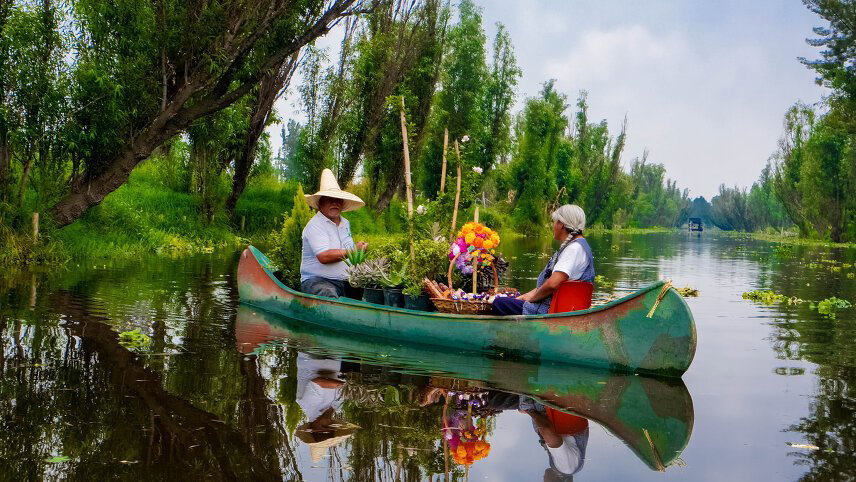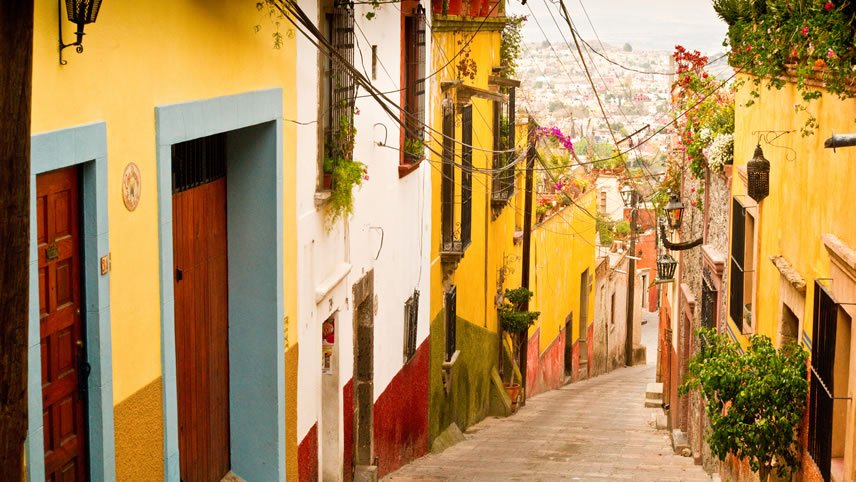Overview
Itinerary
The adventure begins in Mexico City, one of the most exciting capital cities in the world. Take time to settle into the hotel before our welcome briefing this evening. Stay: Hampton Inn & Suites by Hilton (or similar).
Explore the bohemian side of Mexico City. We start by visiting quaint Coyoacán (meaning place of coyotes) with its pebbled streets, colonial churches, bustling little markets and quiet squares. This area was inhabited before the arrival of the Spanish and it is said conquistador Hernan Cortes made this the first capital of New Spain.
Next, we head to Casa Azul (visit subject to availability), where artist Frida Kahlo was born, grew up and, eventually, lived with her muralist husband, Diego Rivera, until she died in 1954 at the age of 47. Now a museum, the cobalt-blue colonial house, set around a luxuriant garden, showcases the collections and personal effects of the two great artists and provides a window into the life of affluent Mexican bohemians in the first half of the 20th century.
Finally, enjoy a ride on a pre-Hispanic boat along the Xochimilco canals. These scenic waterways were used by the Aztecs and today see us enjoying a journey past floating gardens and kitchens selling local food. Return to our hotel in the late afternoon. Stay: Hampton Inn & Suites by Hilton (or similar) (B).
The ancient city of Teotihuacán peaked around 1,000 CE when it was the sixth-biggest city in the world with a population of about 125,000. Among the avenues and structures are the pyramids of the Sun and the Moon, the third and fourth largest pyramids in the world. We explore this impressive archaeological zone with an local guide. Returning to Mexico City, we explore the historic centre on a walking tour. It starts in the main square, known as the Zócalo, but officially named the Plaza de la Constitución. It was an important gathering place for the Aztecs, and remains so in modern Mexico, often hosting book fairs and concerts.
On the north side of the Zócalo is the Cathedral Metropolitana, the largest cathedral in the Americas. It was constructed over an Aztec temple, the Templo Mayor, as a sign the Spanish were now in power. Our tour finishes outside the Palacio de Bellas Artes. Construction of this massive neoclassical building began in 1904, on the remains of the Santa Isabel convent, under the Italian architect Adamo Boari. It has an art nouveau style and its facade is made of marble from Carrara. Stay: Hampton Inn & Suites by Hilton (or similar) (B).
Before leaving Mexico City, we visit the Museum of Anthropology, which has an impressive collection of artefacts from the many civilisations of Mexico. We then transfer (about 2hr 30min) south to Puebla. In the late afternoon, we arrive in Puebla de los Angeles, the City of Angels, named after a legend in which angels came from heaven to place bells in the cathedral towers when builders were unable to do so. The colonial city is known for its traditions, especially its handicrafts, including the blue-and-white talavera pottery. If you'd like to watch artisans create their pieces in a talavera factory, speak to your sales representative about joining an optional visit (payable locally). Stay: Hotel Colonial Puebla (or similar) (B).
Spend this morning exploring Puebla, which has been named a World Heritage site for its colonial architecture. We visit the Patio de los Azulejos and the Ex-Convent of Santa Rosa, both of which provide classic examples of how talavera tiles were incorporated into buildings, inside and out. After, we drive (about 4hr 30min) to Oaxaca, another World Heritage city. With a colonial centre of shaded pedestrian streets, indigenous traditions and a creative atmosphere, Oaxaca has attracted and inspired artists and artisans alike. The city has such sights as the beautiful zócalo (main square), the cathedral and the vast Convento de Santo Domingo, along with museums, fascinating markets and charming inns. Stay: Casa Conzatti (or similar) (B).
Our next exploration of Mexican history takes us to the Zapotecan site of Monte Albán. While the name dates to a 16th-century Spanish landowner, previous names came from the Mixtec word Sahandevul, meaning at the foot of the sky, or from the Zapotecan Danibaan, meaning sacred mountain. In 500 BCE, the Zapotecans moved into the Oaxaca region and began the monumental task of levelling the top of a 5,250ft (1,600m) mountain that intersects and divides three valleys.
Here, they built the city of Monte Albán with a maze of subterranean passageways, rooms, drainage and water-storage systems. We then transfer (30 minutes) to the small village of San Antonio Arrazola, where the local population are known for creating fantastical creatures called alebrijes from wood or papier-mâché. We later return to Oaxaca and explore the cobbled streets, vibrant squares and churches of the historic city. We also visit the Museum of Cultures Santo Domingo. Stay: Casa Conzatti (or similar) (B).
Oaxaca is possibly the most celebrated region in Mexico for its cuisine and we get more acquainted with an authentic cooking class. The experience starts with an exploration of a local market with our tour leader, in which we pick up ingredients for the meal. Then, we drive to our rustic kitchen, where we are taught to cook a full Mexican menu, including tortillas, a main, and dessert, from a Zapotec cook. We take turns to prepare the dishes, sharing the stations and working together. After, we tuck into our delicious creations! The afternoon is free to wander around Oaxaca on your own. Stay: Casa Conzatti (or similar) (B/L).
A short distance from Oaxaca is Teotitlán del Valle, a village known for hand-woven rugs and our first stop today. From here, we continue to a mezcal distillery in Santiago Matatlán to taste the agave-based spirit. Mezcal is produced from the heart of the agave plant and contains more than 40% alcohol! After the tasting, we drive to Tehuantepec, where we spend the night (the total drive time is about seven hours plus stops). Stay: Hotel Calli (or similar) (B).
Today we drive to San Cristóbal (about six hours plus stops), one of the most popular cities in Mexico for visitors. It is filled with cobbled alleyways of whitewashed buildings with red-tiled roofs that lead to plazas and picturesque arcades. Arriving in the afternoon, we have a short orientation tour of the historic city before checking into our hotel. Stay: Hotel Diego Mazariegos (or similar) (B).
Today is a free day to explore San Cristóbal at your own pace. Wander the colonial streets, take in the lively cafes, or buy handicrafts produced by the local Tzotzil indigenous groups. It's also possible to do an optional boat trip through the Sumidero Canyon and/or visit one of the traditional Maya communities who live in the villages surrounding the city. Stay: Hotel Diego Mazariegos (or similar) (B).
Depart San Cristóbal early and spend much of today driving to Palenque, a town named after the impressive ruins nearby. After hotel check-in, those who wish can visit the Roberto Barrios Waterfalls, hidden in the sub-tropical jungle of Chiapas state. Stay: Hotel La Aldea del Halach Huinic (or similar) (B).
Emerging from the jungles of Chiapas is one of the most impressive ruins in Mexico: the Maya site of Palenque. The temples, sanctuaries and pyramids, with sculptured walls and ceilings, are some of the best-preserved and finest examples of Maya buildings despite the city-state having peaked in the seventh century. We explore this magnificent site before continuing to the Yucatán Peninsula and the Caribbean town of Campeche (about five hours plus stops). Yet another World Heritage site, the colonial town has impressive city walls built to protect it from the constant attacks by English and Dutch buccaneers and pirates during the 16th and 17th centuries. We have an orientation tour before dinner. Stay: Hotel Castelmar/ Hotel Lopez (or similar) (B).
About two hours' drive from Campeche is our second Maya site: Uxmal. Quite open, it contrasts the jungle ruins of Palenque we visited yesterday. This site, which dates to the Late Classic era (500 CE to 800 CE), features the Pyramid of the Magician; the Nunnery Quadrangle, which has long, elaborately carved facades; and a ball court, where a traditional ball game was played, sometimes ending in human sacrifice. Having worked up an appetite, we have lunch at a Maya family restaurant.
Here we eat pollo pibil and cochinita pibil (slowly cooked pork and chicken). The meat is roasted for about five hours with achiote paste and wrapped in banana leaves. After lunch, it's about a 1hr 30min drive to Mérida, where several colonial buildings, including the cathedral, were built using stones from nearby Maya ruins. Arriving mid-afternoon, we have a walking tour of Mérida, returning later to enjoy the main square, which is particularly delightful at night. Stay: Hotel Caribe (or similar) (B/L).
Our first stop is Yokdzonot cenote, a natural swimming hole with vertical walls decorated with thick mangrove roots. Take a dip in the fresh water or try your hand at the zipline. We then continue to Izamal, a one-time Maya settlement now marked as a Pueblo Mágico (magic town) by the Mexican government. The town has yellow-and-white buildings and is known for the 16th-century Franciscan monastery built on top of a huge Maya pyramid. From here, we transfer to Chichén Itzá, the best known and perhaps most impressive of all Maya sites (total drive time of about 3hr 30min plus stops). Stay: Hotel Puerta Chichén (or similar) (B).
Our final day starts with a visit to Chichén Itzá. Having spent the night near the site, we can get in early before the day-trippers arrive from the beach resorts. Chichén Itzá served as the political and economic centre of the Maya civilisation and thrived from around 600 CE to 1200 CE. The pyramid of Kukulkan, the Temple of Chac Mool, the Hall of the Thousand Pillars and the Playing Field of the Prisoners can still be seen today and demonstrate an extraordinary commitment to architecture, space and composition. The pyramid itself was the last, and possibly greatest, of all Maya pyramids.
This afternoon, we drive about 2hr 30min to Cancún airport, where the tour ends. Please note: The group transfer back to Cancún is scheduled to align with a chosen flight to London, UK; therefore, you should not book flights leaving before then. Please contact your sales representative for the timings of this flight (B).
Trip Inclusions
- Enjoy incredible culinary and artistic traditions
- Visit ancient temples, cities and colonial towns
- Explore highlands, jungles and coastlines
- 14 Classic nights (hotels)
- Travel by private minibus and boat
- Some long drives
- Special Day of the Dead Festival departures
- All breakfasts and two lunches
- All transport and listed activities
- Tour leader throughout
- Itinerary and inclusions are subject to change
- Price is for land, cruise and internal flights as specified. Flights not specified are not included
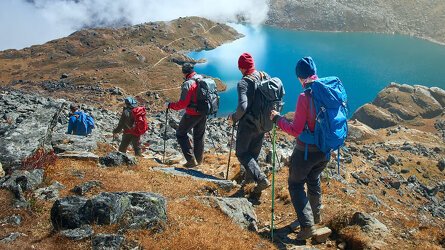
From classic small group tours & family adventures, to walking holidays, cycling trips and self-guided tours. Read more
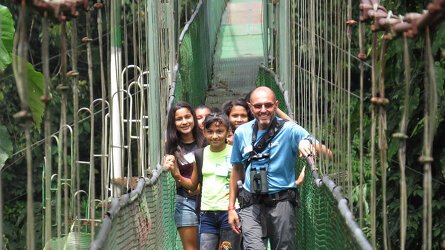
Exodus chooses their Leaders carefully. Professional, dedicated and are passionate about sharing their home countries. Read more
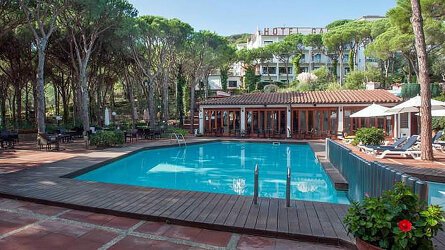
Wherever possible, Exodus chooses properties that are locally owned and that reflect the area you are visiting. Read more
Availability
A definite departure means minimum numbers have been reached for this departure to operate. Your Global Journeys Travel Advisor will check the availability of your departure date when you enquire. Additional savings may apply. We guarantee the lowest price in Australia. T&C’s apply.
Tour & cruises prices are per person. Prices shown have savings applied, are subject to availability and may be withdrawn at any time without notice. Pricing and trip details are correct at this point in time, however are subject to confirmation at the time of booking and are subject to change by Exodus. For cruise itineraries, cabin images are sourced from Exodus. These should be treated as indicative only. Cabin inclusions, upholsteries and room layout may differ to the image(s) shown depending on the ship selected and your sailing dates.
